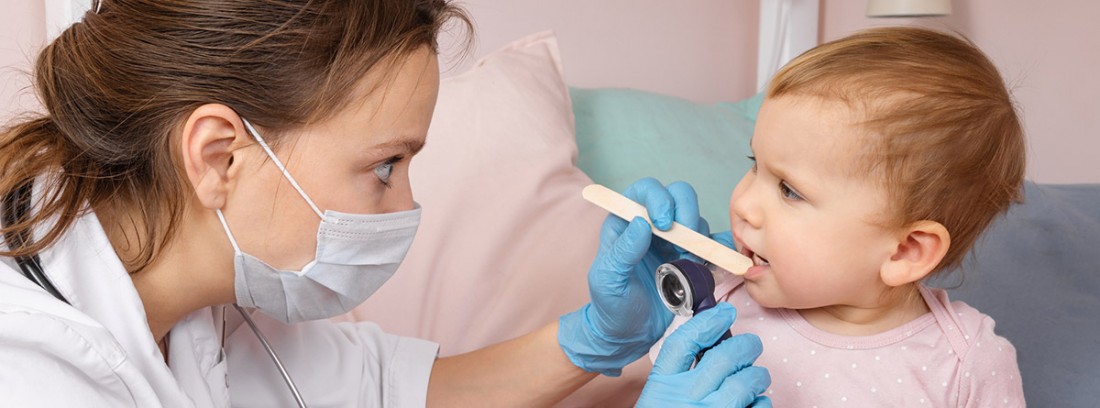What is acute tracheitis?

When we speak of tracheitis we refer to the acute infection of the trachea, while the term croup refers to the symptoms originating from inflammation in the larynx and subglottic airway. However, this term has been used to describe a variety of respiratory conditions in children such as laryngitis, laryngotracheitis, laryngotracheitis, bronchitis, bacterial tracheitis, or spasmodic croup.
What are the causes of tracheitis?
The most common cause is inflammation of trachea it is due to an infectious cause. The origin of infectious tracheitis can be viral or bacterial.
Virus infection
- Parainfluenza
- Influenza
- respiratory syncytial virus
- Adenovirus
- Coronavirus or herpes virus
Except for herpes viruses, viral viruses are common during fall and winter epidemics.
bacterial infection
- Mycoplasma pneumoniae
- Staphylococcus aureus
- Stretococcus pneumoniae or pyogenes
- Haemophilus influenzae
Tracheitis of bacterial origin, therefore, that should be treated with. These are secondary infections, that is, they appear in the course of a viral tracheitis that is complicated by this superinfection.
What are the symptoms depending on the type of infection?
The clinical presentation of tracheitis, tracheobronchitis, and bacterial tracheitis depends on the type of infection and the degree of upper airway obstruction. Stridor is the most characteristic sign of tracheal obstruction.
Yes there are bacterial superinfection, then it can evolve to a bacterial laryngotracheitis that is more serious and can have complications, such as the formation of pseudomembranes that can cover part of the upper airway, the trachea and even affect the bronchi. Stridor is the most characteristic sign of tracheal obstruction.
Laryngotracheitis
Is the more common in children between 3 months and 3 years. It is characterized by a gradual onset clinic:
- Starts with symptoms of a common cold (runny nose, nasal congestion)
- It progresses over the next 12 to 48 hours to a dry cough, hoarseness, fever, and stridor.
- respiratory distress will increase in function as upper airway obstruction increases.
The table is resolved between the three to seven days. The presence of respiratory distress is an indicator of severity and progression of the obstruction and should always be evaluated in the emergency room.
Laryngotracheobronchitis
The inflammation affects the trachea and spreads to the bronchi, being a more serious condition than laryngotracheitis alone. If it gets complicated it can lead to one. The usual symptoms are:
- Symptoms of laryngotracheitis
- Symptoms and signs of bronchial involvement such as wheezing with increased respiratory distress.
Bacterial tracheitis or bacterial croup
Although the most frequent origin is usually bacterial superinfection after a viral infection, it is not uncommon for it to present as a primary bacterial infection, especially in patients who have required endotracheal intubation or tracheostomies.
- It begins with the same symptoms of upper airway involvement for about 3 days.
- Later more serious symptoms appear such as stridor, cough, respiratory distress and fever.
Pseudomembranous tracheitis
It is characterized by a pseudomembrane that partially or completely covers the tracheobronchial tree and produces greater airway obstruction. It can be a serious complication of bacterial tracheitis or it can occur in immunosuppressed patients. It can be caused by bacteria or fungi, as o The clinic is similar to that of bacterial tracheitis, but more serious, with greater respiratory distress, very high fever and very poor general condition.
Which is the treatment?
Most cases are mild and self-limited, so they can be successfully treated at the health center. However, if the pediatrician detects signs of alarm or seriousness, the child must be transferred to a hospital.
CALCULATE YOUR PRICE
There is no specific treatment for those of viral etiology. The therapy is focused on decrease inflammation in the respiratory tract, give respiratory support and maintain a correct state of hydration.
The most widely used pharmacological treatment is antipyretics and adrenaline or. In the most severe cases, oral or intramuscular corticosteroids, bronchodilators (when there is bronchial involvement) and antibiotics can be administered if a bacterial cause or superinfection is suspected. In the most serious cases, hospital admission may be required.
- When we speak of tracheitis we refer to the acute infection of the trachea.
- The most frequent cause is the inflammation of the trachea is due to an infectious cause. The origin of infectious tracheitis can be viral or bacterial.
- Most cases are mild and self-limited, so they can be successfully treated on an outpatient basis and followed by the pediatrician at the health center.
(Updated at Apr 14 / 2024)